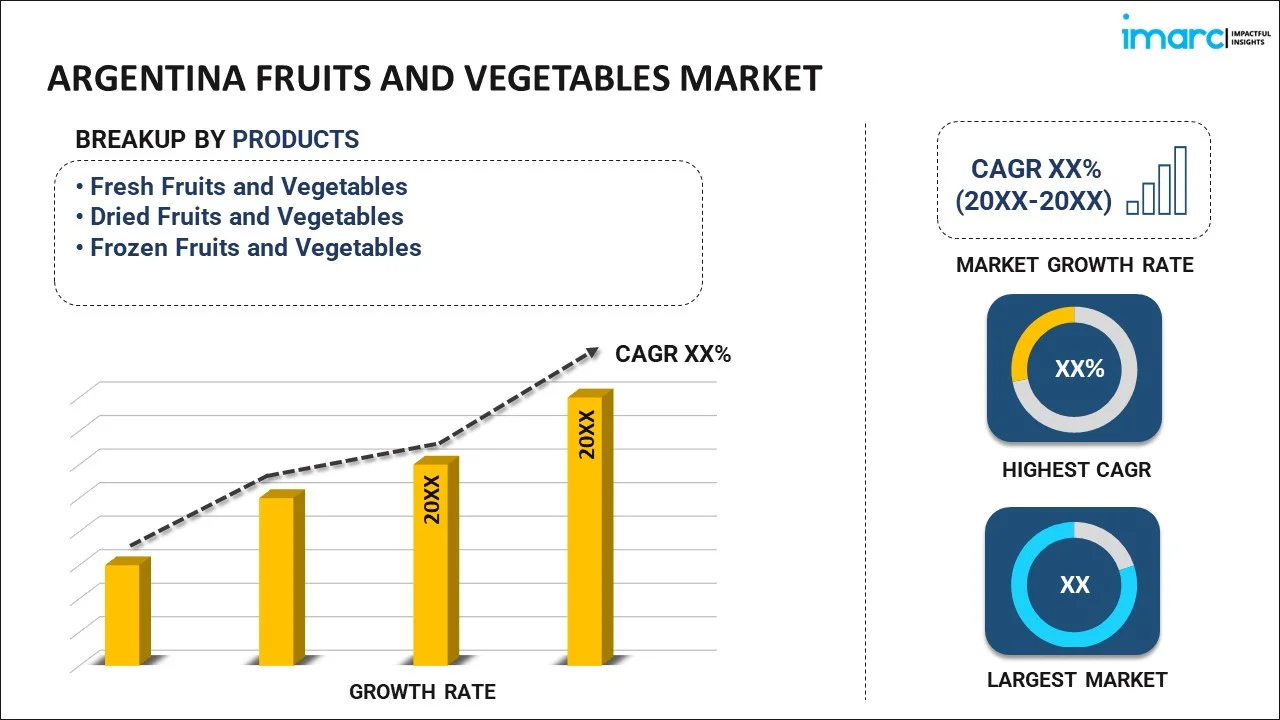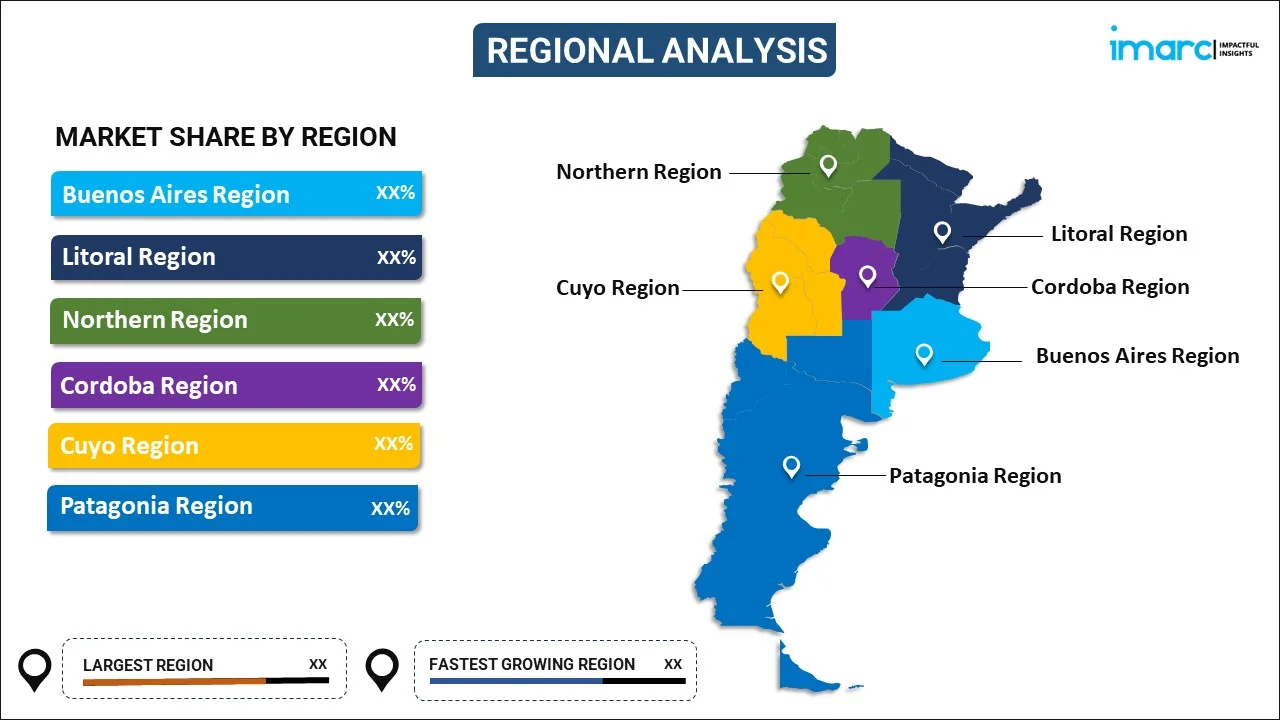
Argentina Fruits and Vegetables Market Report by Product (Fresh Fruits and Vegetables, Dried Fruits and Vegetables, Frozen Fruits and Vegetables), Distribution Channel (Supermarkets and Hypermarkets, Grocery Stores, Online, and Others), and Region 2025-2033
Argentina Fruits and Vegetables Market Overview:
The Argentina fruits and vegetables market size is projected to exhibit a growth rate (CAGR) of 4.80% during 2025-2033. The increasing health consciousness, the rising demand for organic produce, advancements in agricultural technology, strong export opportunities, government support for sustainable farming practices, and the growing popularity of plant-based diets are some of the major factors driving the market growth.
|
Report Attribute
|
Key Statistics
|
|---|---|
|
Base Year
|
2024 |
|
Forecast Years
|
2025-2033
|
|
Historical Years
|
2019-2024
|
| Market Growth Rate (2025-2033) | 4.80% |
Argentina Fruits and Vegetables Market Trends:
Rising Health Consciousness and Dietary Shifts
The increasing awareness of the health benefits associated with fresh produce is driving the consumer demand for fruits and vegetables in the country. This trend is bolstered by a growing preference for plant-based diets and a focus on natural, nutrient-rich foods. For instance, Argentina’s Association of Plant-Based Producers shared a report with the media outlet iProUP, revealing that the plant-based sector, comprised of 1,200 companies, has a market volume of more than $110,000 million per year. The figures also revealed that the association’s 130 companies grew by at least 35% in 2021, and a 45% increase is expected in two years. Investments estimated at $2 billion are underway, rising to $7 billion by 2024. According to the global nutrition report, some progress has been made towards achieving the target of reducing anaemia among women of reproductive age, with 11.9% of women aged 15 to 49 years now affected. Argentina has shown limited progress towards achieving the diet-related non-communicable disease (NCD) targets. 31.7% of adult (aged 18 years and over) women and 30.2% of adult men are living with obesity. Argentina's obesity prevalence is higher than the regional average of 30.7% for women and 22.8% for men. At the same time, diabetes is estimated to affect 10.5% of adult women and 10.6% of adult men.
Growing Government Support and Technological Advancements
Government initiatives promoting sustainable farming practices and investments in agricultural technology improve productivity and efficiency. These advancements help farmers meet both domestic and international demand while ensuring the sustainability of agricultural practices. For instance, in 2023, Argentina announced to launch of measures to help producers hit by a historic drought over its main agricultural region, Economy Minister Sergio Massa said, including a relief fund to tackle considerable losses to the country's grain harvests. The ministry will give producers access to a 5 billion pesos ($27 million) relief fund, Massa said after a meeting with the South American country's main rural associations. Argentina is the world's leading exporter of soybean processed oil and meal, and the world's No. 3 corn exporter, but the drought that began in May delayed farmers from planting their crops while grains exchange slashed estimates. Massa also announced other measures, such as the suspension of advance income tax payments for producers in areas hardest hit by the drought, smaller interest rates, and bigger subsidies. Similarly, in April 2023, the national government presented a basket of "Fair Prices" for fruits and vegetables, which will be available in AMBA supermarkets and suppliers that operate in the Central Market from tomorrow until April 30. The prices and products are the wholesale suppliers participating in the agreement are CAMABANA (Cámara Argentina de Banana y Afines), Kleppe S.A., Frutihortícola Saturno S.R.L., Patagonia Sunrise S.R.L., Pradan S.R.L., Agropecuaria El Corralito S.A., Frutamax S.R.L., Cuadro Norte S.R.L., Maguos S.R.L. and Palmala S.R.L. The Government maintains the policy of price agreements as tools to mitigate the inflationary scale.
Argentina Fruits and Vegetables Market News:
- In April 2024, World Citrus Organisation members gathered for their fifth annual general meeting. During the AGM, the WCO presented the consolidated data of the production and export forecasts for the forthcoming 2024 Southern Hemisphere citrus season. The preliminary forecast was collected thanks to WCO members in Argentina, Australia, Bolivia, Brazil, Chile, Peru, South Africa and Uruguay. In addition to this, the association also marked its first change in leadership with the election of a new steering committee that will guide its work in the upcoming two years.
- In February 2024, – On the occasion of its annual general meeting at Fruit Logistica, the World Apple and Pear Association (WAPA) released the Southern Hemisphere apple and pear crop forecast for the upcoming season. According to the forecast, which consolidates the data from Argentina, Australia, Brazil, Chile, New Zealand and South Africa, apple production is set to grow by 1.1% compared with 2023, while the pear crop is expected to decrease by 2.3%.
Argentina Fruits and Vegetables Market Segmentation:
IMARC Group provides an analysis of the key trends in each segment of the market, along with forecasts at the country level for 2025-2033. Our report has categorized the market based on product and distribution channel.
Product Insights:

- Fresh Fruits and Vegetables
- Dried Fruits and Vegetables
- Frozen Fruits and Vegetables
The report has provided a detailed breakup and analysis of the market based on the product. This includes fresh fruits and vegetables, dried fruits and vegetables, and frozen fruits and vegetables.
Distribution Channel Insights:
- Supermarkets and Hypermarkets
- Grocery Stores
- Online
- Others
A detailed breakup and analysis of the market based on the distribution channel have also been provided in the report. This includes supermarkets and hypermarkets, grocery stores, online, and others.
Regional Insights:

- Buenos Aires Region
- Litoral Region
- Northern Region
- Cordoba Region
- Cuyo Region
- Patagonia Region
The report has also provided a comprehensive analysis of all the major regional markets, which include Buenos Aires Region, Litoral Region, Northern Region, Cordoba Region, Cuyo Region, and Patagonia Region.
Competitive Landscape:
The market research report has also provided a comprehensive analysis of the competitive landscape. Competitive analysis such as market structure, key player positioning, top winning strategies, competitive dashboard, and company evaluation quadrant has been covered in the report. Also, detailed profiles of all major companies have been provided.
Argentina Fruits and Vegetables Market Report Coverage:
| Report Features | Details |
|---|---|
| Base Year of the Analysis | 2024 |
| Historical Period | 2019-2024 |
| Forecast Period | 2025-2033 |
| Units | Million USD |
| Scope of the Report | Exploration of Historical and Forecast Trends, Industry Catalysts and Challenges, Segment-Wise Historical and Predictive Market Assessment:
|
| Products Covered | Fresh Fruits and Vegetables, Dried Fruits and Vegetables, Frozen Fruits and Vegetables |
| Distribution Channels Covered | Supermarkets and Hypermarkets, Grocery Stores, Online, Others |
| Regions Covered | Buenos Aires Region, Litoral Region, Northern Region, Cordoba Region, Cuyo Region, Patagonia Region |
| Customization Scope | 10% Free Customization |
| Post-Sale Analyst Support | 10-12 Weeks |
| Delivery Format | PDF and Excel through Email (We can also provide the editable version of the report in PPT/Word format on special request) |
Key Questions Answered in This Report:
- How has the Argentina fruits and vegetables market performed so far and how will it perform in the coming years?
- What has been the impact of COVID-19 on the Argentina fruits and vegetables market?
- What is the breakup of the Argentina fruits and vegetables market on the basis of product?
- What is the breakup of the Argentina fruits and vegetables market on the basis of distribution channel?
- What are the various stages in the value chain of the Argentina fruits and vegetables market?
- What are the key driving factors and challenges in the Argentina fruits and vegetables?
- What is the structure of the Argentina fruits and vegetables market and who are the key players?
- What is the degree of competition in the Argentina fruits and vegetables market?
Key Benefits for Stakeholders:
- IMARC’s industry report offers a comprehensive quantitative analysis of various market segments, historical and current market trends, market forecasts, and dynamics of the Argentina fruits and vegetables market from 2019-2033.
- The research report provides the latest information on the market drivers, challenges, and opportunities in the Argentina fruits and vegetables market.
- Porter's five forces analysis assist stakeholders in assessing the impact of new entrants, competitive rivalry, supplier power, buyer power, and the threat of substitution. It helps stakeholders to analyze the level of competition within the Argentina fruits and vegetables industry and its attractiveness.
- Competitive landscape allows stakeholders to understand their competitive environment and provides an insight into the current positions of key players in the market.
Need more help?
- Speak to our experienced analysts for insights on the current market scenarios.
- Include additional segments and countries to customize the report as per your requirement.
- Gain an unparalleled competitive advantage in your domain by understanding how to utilize the report and positively impacting your operations and revenue.
- For further assistance, please connect with our analysts.

 Inquire Before Buying
Inquire Before Buying
 Speak to an Analyst
Speak to an Analyst
 Request Brochure
Request Brochure
 Request Customization
Request Customization



.webp)




.webp)












